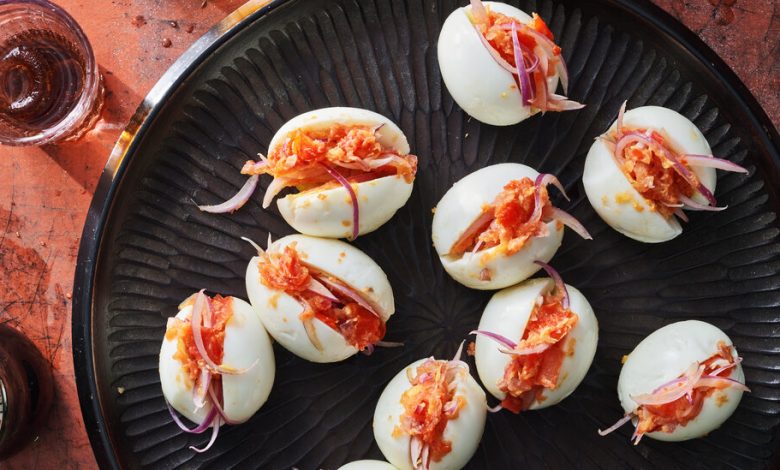An Even Better Way to Eat Eggs

Now that I’ve settled into the warm weather and its rituals, market runs and farm visits, ripening fruits crowd my kitchen counters, fresh greens burst from my crisper bin and tomatoes, chiles and lemongrass await, gifts from my little garden patch.
Recipe: Kosua ne Meko
And, once the hottest August afternoons arrive, I find myself navigating two competing desires: using up every ingredient I have on hand, and turning on my stovetop as infrequently as possible.
Cue kosua ne meko, a popular Ghanaian street snack of a hard-boiled egg split slightly down the middle and stuffed with a chunky tomato relish.
“You never, ever have just one,” said Fafa Gilbert, a London-based Ghanaian home cook who runs the YouTube channel “Ndudu by Fafa,” adding, “It’s about the process and excitement of buying one egg, then two, three and four and literally begging the lady to let you go.”
I first encountered these brightly dressed eggs while sitting under the warm, shade-speckled light of a large tree in Prospect Park, Brooklyn. A few friends and I had successfully wrangled our busy schedules, gathering our partners and kids on a large patterned blanket for a picnic. We caught up excitedly, filling our plates with snacks, including these eggs. The jewel tones of their juicy red and purple garnish stood out against the firm-set, oval whites. In one bite, I was hit with the sweet acidity of summer tomatoes, tempered by a creamy soft-boiled yolk. The crunch of raw red onions and a tingle from Scotch bonnets accented each subsequent bite.
In addition to getting the most out of those tomatoes ripening on my counter, kosua ne meko is quick to make and easy to share broadly at the beach, an afternoon cocktail party or a potluck brunch. I can take enough for almost any group with just a small container of boiled eggs and a smaller container for the relish. But I can also stuff them before I go, nestling them side-by-side in a wide Tupperware. (Doing so allows the relish to seep into the eggs’ yolks and whites, which gives each bite a balance of fresh produce and juicy marinade.)
Like other great dishes that are nominally considered street foods, kosua ne meko can be intimidating to even the most experienced cooks.
Ms. Gilbert describes the vendors in Ghana as having perfected the intensity of flavors in every ingredient, even curing the eggs by dredging the shell-on cooked eggs in dampened salt a day before. At vendor stands, the shells take on an almost crystalline sheen at their perches, awaiting an approaching customer.
The relish, referred to as “raw pepper,” can also taste different depending on the freshness of ingredients and variety of chile used. A classic raw pepper has tomatoes, red onions, a chile and a little salt.
This version, similar to Ms. Gilbert’s, adds ginger and garlic to those ingredients, but they’re only a starting point. The relish can be made with mild or hot peppers, and simply salting the eggs before adding the relish — or after — can at least hint at the salt-dredging techniques of Ghanaian vendors.
“When I make it at home, it doesn’t taste the same,” she said. But it can come close.
Follow New York Times Cooking on Instagram, Facebook, YouTube, TikTok and Pinterest. Get regular updates from New York Times Cooking, with recipe suggestions, cooking tips and shopping advice.




